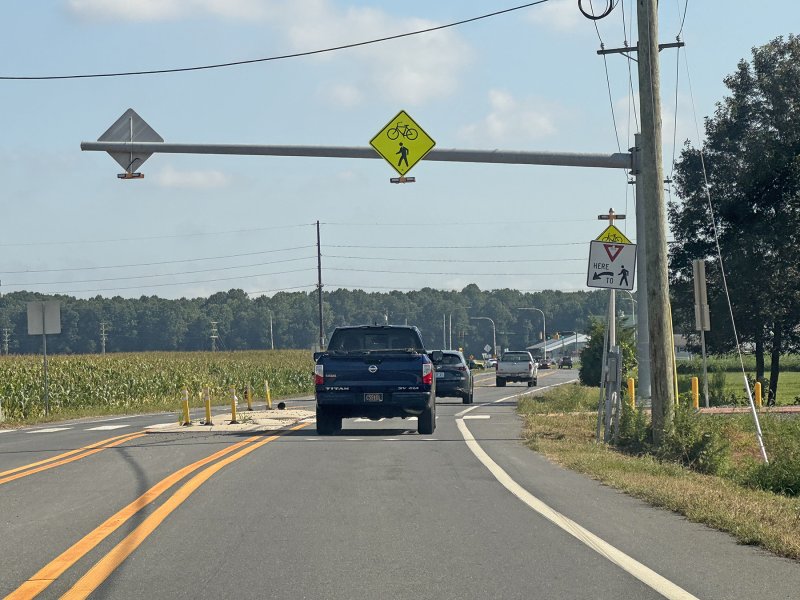DelDOT changes warning lights at Sweetbriar Road crossing
A 60-year-old Rehoboth Beach man was critically injured Aug. 9, at the trail crossing on Sweetbriar Road outside Lewes.
While details regarding the accident remain unclear, the incident has drawn attention to the safety of trail crossings in the Cape Region.
Pamela Plaza of Lewes noticed recently that the overhead warning lights no longer turn on as bicyclists or pedestrians on the Lewes-to-Georgetown Trail approach Sweetbriar Road.
“I have seen bikers, walkers and traffic not stop when they approach that intersection,” she wrote to the Cape Gazette in July. “Visibility is limited with the full-grown corn and trees in full bloom.”
Delaware Department of Transportation spokesman Charles “CR” McLeod confirmed changes have been made to the warning lights.
“The trail crossing at Sweetbriar Road was converted to the push button-activated signal in late July, as the sensors that were previously in place to automatically trigger the flashing lights were proving to be unreliable and not activating every time a bike or pedestrian would approach,” he said.
Trail signage indicating bicyclists and pedestrians should stop before crossing the road remains in place, he said.
“We know users of the trail like the sensors; however, it also created concern that bicyclists primarily would just assume they could cross the road without stopping or yielding,” McLeod said. “Even with signs, flashing lights, medians, we know that drivers do not always respond and stop.”
DelDOT does not currently collect data on incidents that occur on the trail or specific crossings, he said, noting he’s aware there was another bicycle-versus-vehicle crash at the Sweetbriar crossing in August 2024.
McLeod said the safest option is to build bridges over roads, but those are very costly.
He said DelDOT expects trail usage to grow as the last segment of the Lewes-to-Georgetown Trail is completed.
“In the short term, ensuring there is good visibility and signage in place for both vehicles and trail users is our primary focus,” he said.
As a reminder, Delaware Code reads:
• A bicycle operator approaching a stop sign at an intersection with a roadway having two or fewer lanes for moving traffic shall reduce speed and, if required for safety, stop before entering the intersection. After slowing to a reasonable speed or stopping, the person shall yield the right-of-way to any vehicle in the intersection or approaching on another roadway so closely as to constitute an immediate hazard during the time the person is moving across or within the intersection, except that a person, after slowing to a reasonable speed and yielding the right-of-way if required, may cautiously make a turn or proceed through the intersection without stopping
• A bicycle operator approaching an intersection shall always yield the right-of-way to any vehicle that has already entered the intersection
• When a bicycle and a vehicle enter an intersection from different roadways at approximately the same time, the operator of the vehicle or bicycle on the left shall yield the right-of-way to the vehicle or bicycle on the right.
Nick Roth is the news editor. He has been with the Cape Gazette since 2012, previously covering town beats in Milton and Lewes. In addition to serving on the editorial board and handling page layout, Nick is responsible for the weekly Delaware History in Photographs feature and enjoys writing stories about the Cape Region’s history. Prior to the Cape Gazette, Nick worked for the Delmarva Media Group, including the Delaware Wave, Delaware Coast Press and Salisbury Daily Times. He also contributed to The News Journal. Originally from Boyertown, Pa., Nick attended Shippensburg University in central Pennsylvania, graduating in 2007 with a bachelor’s degree in journalism. He’s won several MDDC awards during his career for both writing and photography. In his free time, he enjoys golfing, going to the beach with his family and cheering for Philadelphia sports teams.





















































